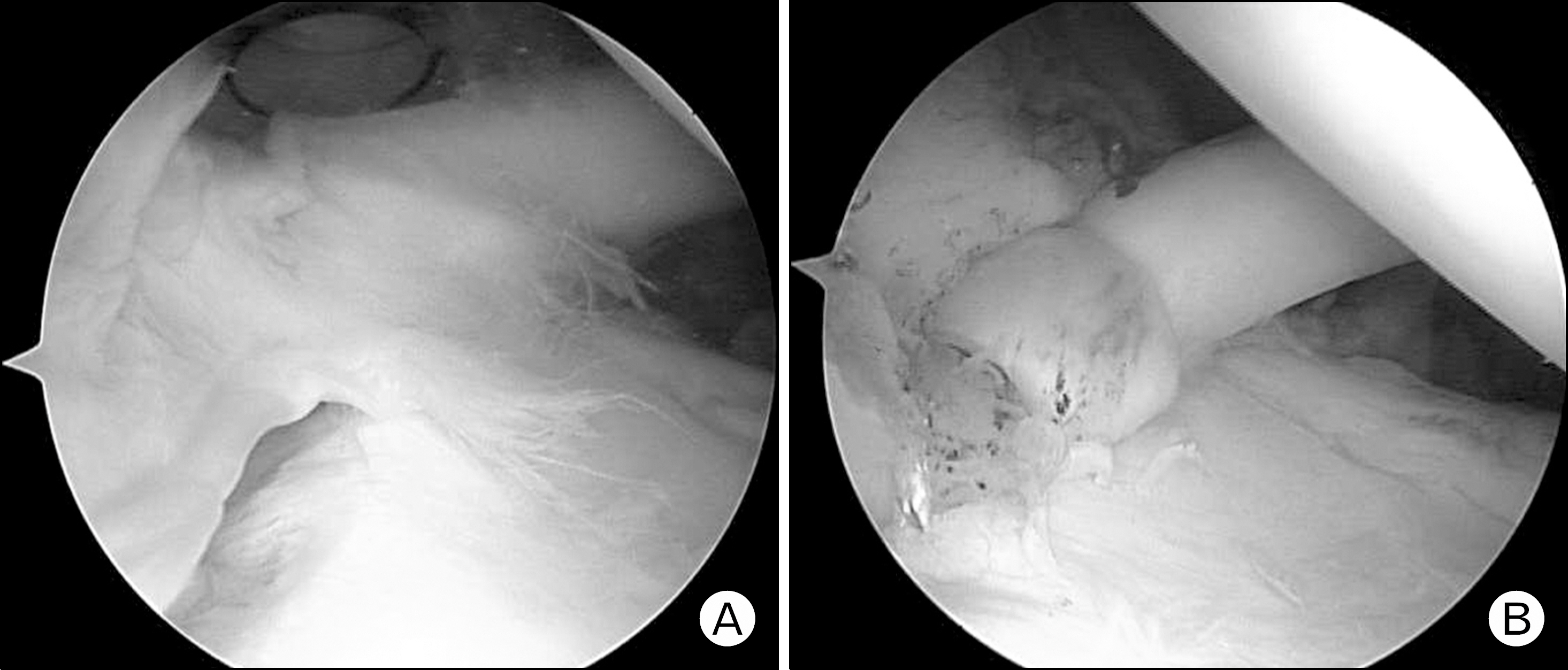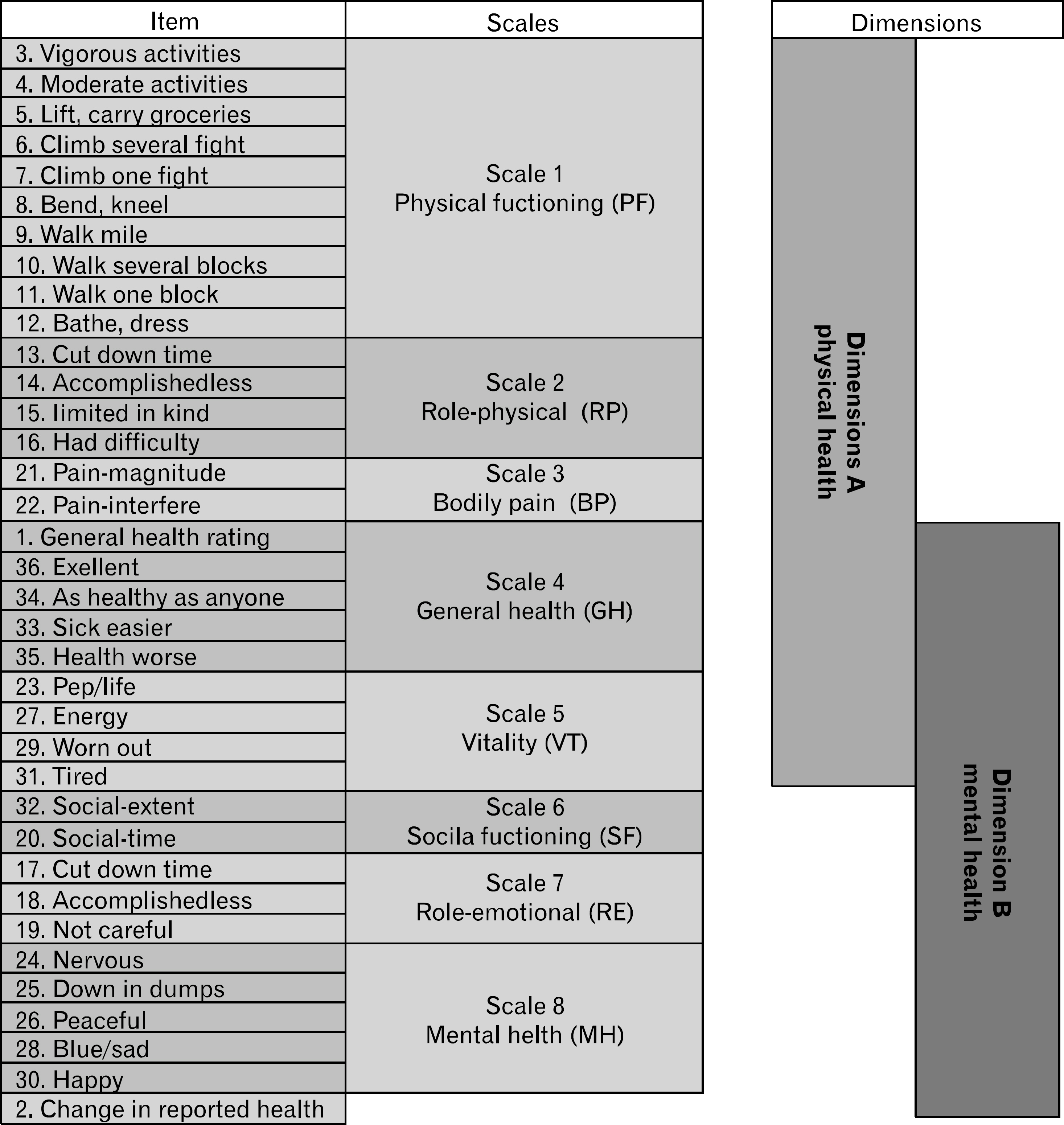Korean J Sports Med.
2014 Jun;32(1):7-13. 10.5763/kjsm.2014.32.1.7.
The Clinical Outcomes and Assessment of Quality of Life in Arthroscopic Repair of Isolated Type II Superior Labral Anterior and Posterior Lesion Caused by Sports Injuries from Public
- Affiliations
-
- 1Department of Orthopedic Surgery, Wonkwang University School of Medicine, Iksan, Korea. serina@wonkwang.ac.kr
- 2Wonkwang Medical Science Research Center, Iksan, Korea.
- 3Department of Orthopedic Surgery, Presbyterian Medical Center, Jeonju, Korea.
- 4Department of Nursing Science, Chodang University, Muan, Korea.
- KMID: 2288684
- DOI: http://doi.org/10.5763/kjsm.2014.32.1.7
Abstract
- The purpose of this study was to morphologically classify the superior labral anterior and posterior (SLAP) lesion in people with athletic injuries and further research into the clinical result of arthroscopic repair of type II SLAP lesions. January 2005 to June 2012 occurred after sports activity in patients with shoulder pain diagnosed with isolated SLAP lesion by magnetic resonance imaging and arthroscopy were classified according to the tear type. Of these patients, 40 cases of type II SLAP patients were evaluated using American Shoulder and Elbow Surgeons (ASES) questionnaire and range of motion. Also satisfaction of surgery was evaluated by following up through phone calls using translated short form-36 (SF-36). At average of 35 months postoperatively, external rotation decreased slightly from 60.4 degrees to 56.2 degrees, forward elevation and internal rotation were both recovered to a range of pre-surgery but no significant changes were noticed statistically (p>0.05). Visual analogue scale, ASES scores, physical component summary, and mental component summary of SF-36 improved from 5, 1 to 1.2 (p=0.01), from 65.4 to 91.5 (p=0.017), 42.6 to 52.5 (p=0.047), and from 48.5 52.6 to (p=0.036), respectively. In comparison of a group of patients over forty years and less than forty, both groups showed good results, but group of patients less than forty years showed more improvement in pain relief, functional test, and postoperational satisfaction (p=0.004). Arthroscopic repair showed good results in patients with type II SLAP lesion due to athletic injuries especially when they were less than 40 years and it can be regarded as a good treatment with high satisfaction.
Keyword
MeSH Terms
Figure
Reference
-
1. Maffet MW, Gartsman GM, Moseley B. Superior labrum- biceps tendon complex lesions of the shoulder. Am J Sports Med. 1995; 23:93–8.2. Coleman SH, Cohen DB, Drakos MC, et al. Arthroscopic repair of type II superior labral anterior posterior lesions with and without acromioplasty: a clinical analysis of 50 patients. Am J Sports Med. 2007; 35:749–53.3. Rhee YG, Lee DH, Lim CT. Unstable isolated SLAP lesion: clinical presentation and outcome of arthroscopic fixation. Arthroscopy. 2005; 21:1099.
Article4. Angelo RL, Esch J, Ryu RK. AANA Advanced Arthroscopy: the shoulder. Philadelphia: Saunders/Elsevier;2010.5. Sharma P, Maffulli N. Tendon injury and tendinopathy: healing and repair. J Bone Joint Surg Am. 2005; 87:187–202.6. Ware JE Jr, Sherbourne CD. The MOS 36-item short-form health survey (SF-36). I. Conceptual framework and item selection. Med Care. 1992; 30:473–83.7. Koh SB, Chang SJ, Kang MG, Cha BS, Park JK. Reliability and validity on measurement instrument for health status assessment in occupational workers. Korean J Prev Med. 1997; 30:251–66.9. Snyder SJ, Banas MP, Karzel RP. An analysis of 140 injuries to the superior glenoid labrum. J Shoulder Elbow Surg. 1995; 4:243–8.
Article10. Handelberg F, Willems S, Shahabpour M, Huskin JP, Kuta J. SLAP lesions: a retrospective multicenter study. Arthroscopy. 1998; 14:856–62.
Article11. Burkhart SS, Morgan CD. The peel-back mechanism: its role in producing and extending posterior type II SLAP lesions and its effect on SLAP repair rehabilitation. Arthroscopy. 1998; 14:637–40.
Article12. Jobe CM. Posterior superior glenoid impingement: expanded spectrum. Arthroscopy. 1995; 11:530–6.
Article13. Katz LM, Hsu S, Miller SL, et al. Poor outcomes after SLAP repair: descriptive analysis and prognosis. Arthroscopy. 2009; 25:849–55.
Article14. Andrews JR, Carson WG Jr, McLeod WD. Glenoid labrum tears related to the long head of the biceps. Am J Sports Med. 1985; 13:337–41.
Article15. Snyder SJ, Karzel RP, Del Pizzo W, Ferkel RD, Friedman MJ. SLAP lesions of the shoulder. Arthroscopy. 1990; 6:274–9.
Article16. Brockmeier SF, Voos JE, Williams RJ 3rd, et al. Outcomes after arthroscopic repair of type-II SLAP lesions. J Bone Joint Surg Am. 2009; 91:1595–603.
Article17. Cohen DB, Coleman S, Drakos MC, et al. Outcomes of isolated type II SLAP lesions treated with arthroscopic fixation using a bioabsorbable tack. Arthroscopy. 2006; 22:136–42.
Article18. Ozbaydar MU, Tekin C, Kocabas R, Yalaman O. Arthroscopic treatment of type 2 superior labrum anterior posterior lesions. Acta Orthop Traumatol Turc. 2006; 40:349–55.19. Abbot AE, Li X, Busconi BD. Arthroscopic treatment of concomitant superior labral anterior posterior (SLAP) lesions and rotator cuff tears in patients over the age of 45 years. Am J Sports Med. 2009; 37:1358–62.
Article20. Schroder CP, Skare O, Gjengedal E, Uppheim G, Reikeras O, Brox JI. Longterm results after SLAP repair: a 5-year followup study of 107 patients with comparison of patients aged over and under 40 years. Arthroscopy. 2012; 28:1601–7.
- Full Text Links
- Actions
-
Cited
- CITED
-
- Close
- Share
- Similar articles
-
- Superior Labrum Anterior to Posterior (SLAP) Lesion with Glenohumeral Instability
- Orthopedic disease and sports medicine in shoulder joint
- Comparison of Superior Labral Anterior Posterior (SLAP) Lesions: Sports versus Non-sports Induced Injury
- Problem Solving for Failed Superior Labrum Anterior to Posterior (SLAP) Repair
- Follow-up Result in Repairing a Type II Superior Labrum Anterior and Posterior (SLAP) Lesion when Associated with Shoulder Impingement Syndrome



